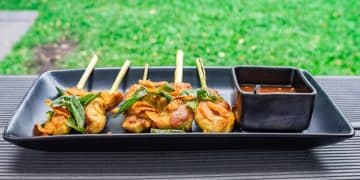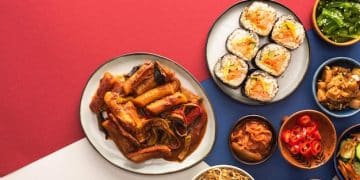Korean Cuisine Trends in the US: 7 Popular Dishes This Year
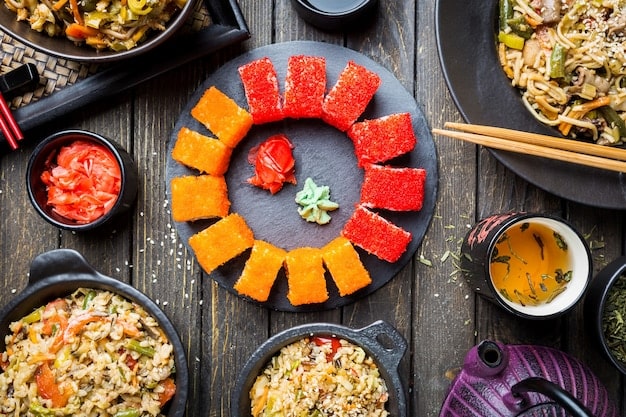
Korean Cuisine Trends in the US: 7 Dishes Gaining Popularity This Year explores the rising favor of Korean flavors in the United States, highlighting dishes like Kimchi Jjigae and Korean Fried Chicken that are capturing American palates.
Korean cuisine is rapidly gaining popularity in the US, with more and more Americans developing a taste for its bold flavors and unique dishes. This year, several Korean dishes are standing out as must-try culinary experiences. Let’s dive into the Korean Cuisine Trends in the US: 7 Dishes Gaining Popularity This Year.
Discover the Hottest Korean Cuisine Trends in the US
Korean food has become a significant part of the American culinary landscape. From bustling food trucks to upscale restaurants, Korean flavors are readily accessible and increasingly sought after. The cultural exchange is contributing significantly to the diversity of tastes available across the US.
The Rise of Korean Food Culture in America
The popularity of Korean cuisine is not just a fleeting trend; it’s a cultural phenomenon. The influence of Korean pop culture, often referred to as K-Culture, has played a huge role in introducing Korean food to a wider audience.
- Social Media Influence: Platforms like Instagram and TikTok showcase visually appealing Korean dishes, driving curiosity and demand.
- K-Dramas and Entertainment: Popular Korean TV shows often feature scenes of people enjoying various Korean foods, sparking interest among viewers.
- Celebrity Endorsements: High-profile chefs and food bloggers promote Korean restaurants and recipes, further boosting their popularity.
Korean cuisine offers a wide range of flavors and textures that appeal to different palates. From the fiery spice of tteokbokki to the savory richness of bulgogi, there is something for everyone to savor.
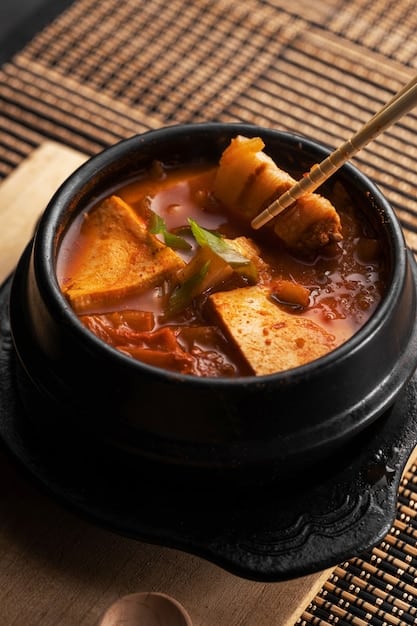
Kimchi Jjigae: The Quintessential Comfort Food
Kimchi Jjigae, or kimchi stew, is a staple in Korean cuisine, offering a spicy, savory, and comforting experience. It’s made primarily with kimchi, tofu, pork (or seafood), and vegetables, simmered in a rich broth.
Why Kimchi Jjigae Is Beloved
This hearty stew is more than just a meal; it’s a cultural symbol. It’s often enjoyed during cold weather or when one is seeking a flavorful, satisfying dish. The fermentation process of kimchi also adds a unique depth of flavor and nutritional benefits.
- Flavor Profile: A perfect balance of spicy, sour, and umami flavors that create a complex and addictive taste.
- Versatility: Can be customized with different ingredients such as mushrooms, glass noodles, or additional vegetables to suit personal preferences.
- Health Benefits: Kimchi is rich in probiotics, which promote gut health, making this dish both delicious and nutritious.
Kimchi Jjigae is celebrated for its ability to warm and comfort, making it a must-try for anyone exploring Korean cuisine.
Korean Fried Chicken: A Crispy Sensation
Korean fried chicken (KFC) has taken the world by storm, and the US is no exception. What sets it apart from American fried chicken is its extra crispy skin, flavorful sauces, and unique preparation methods.
The Secret Behind Korean Fried Chicken’s Crunch
The double-frying technique is a key to achieving the perfect crunch. The chicken is first fried at a lower temperature to cook it through, then fried again at a higher temperature to achieve a crispy exterior.
Another distinctive feature is the sauces. Korean fried chicken is often coated in flavorful sauces like:
- Gochujang Sauce: A sweet, spicy, and savory sauce made from fermented chili paste.
- Soy Garlic Sauce: A classic combination of soy sauce and garlic that offers a balance of savory and sweet flavors.
- Honey Butter Sauce: A sweet and buttery sauce that adds a touch of indulgence to the crispy chicken.
The combination of crispy skin and flavorful sauces makes Korean fried chicken an irresistible treat.
Bibimbap: A Colorful and Nutritious Bowl
Bibimbap is a mixed rice dish that is as visually appealing as it is delicious. It typically consists of rice, seasoned vegetables, meat (usually beef), a fried egg, and gochujang (chili pepper paste).
Bibimbap: More Than Just a Meal
The dish is designed to provide a balanced mix of flavors and nutrients in a single bowl. The vegetables add freshness and vitamins, the meat provides protein, and the gochujang adds a spicy kick.
There are several variations of bibimbap:
- Dolsot Bibimbap: Served in a hot stone bowl, which creates a crispy layer of rice at the bottom.
- Yukhoe Bibimbap: Features raw beef, adding a unique texture and flavor.
- Vegetarian Bibimbap: Substitutes meat with tofu or additional vegetables.
Bibimbap is a versatile dish that can be adapted to suit different dietary preferences and tastes.
Bulgogi: The Sweet and Savory Delight
Bulgogi, meaning “fire meat,” is thinly sliced marinated beef that is grilled or stir-fried. The marinade typically includes soy sauce, sugar, sesame oil, garlic, and ginger giving the meat a sweet and savory flavor.
The Art of Bulgogi Preparation
The marinating process tenderizes the meat and infuses it with rich flavors. The beef is usually marinated for at least 30 minutes, but longer marinating times result in even more flavorful and tender meat.
Bulgogi is often served with:
- Lettuce Wraps: The grilled beef is wrapped in lettuce leaves along with rice, kimchi, and other toppings.
- Rice Bowls: Served over rice with a variety of side dishes.
- Stir-fries: Mixed with vegetables and noodles for a complete meal.
Bulgogi’s tender texture and balanced flavor make it a favorite among both Korean food enthusiasts and newcomers.
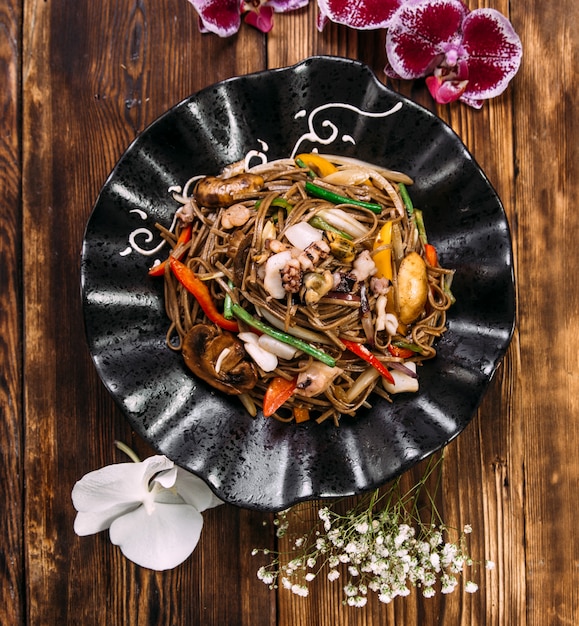
Japchae: The Festive Noodle Dish
Japchae is a glass noodle dish made with sweet potato noodles, stir-fried vegetables, and often meat. The noodles are known for their chewy texture and slightly sweet flavor, and the dish is usually seasoned with soy sauce and sesame oil.
Japchae: A Staple at Celebrations
Japchae is commonly served at Korean parties and celebrations because it is considered a festive and crowd-pleasing dish. The colorful vegetables and flavorful noodles make it a visual and culinary treat.
Key components of Japchae include:
- Glass Noodles: Made from sweet potato starch, giving them a unique texture and translucent appearance.
- Assorted Vegetables: Typically includes carrots, spinach, onions, mushrooms, and bell peppers.
- Seasonings: Flavored with soy sauce, sesame oil, garlic, and sugar, creating a balance of sweet and savory flavors.
Japchae is a delightful dish that combines textures and flavors, making it a popular choice for any occasion.
Tteokbokki: The Spicy Street Food Sensation
Tteokbokki is a popular Korean street food made with chewy rice cakes, fish cakes, and gochujang sauce. It is known for its spicy and savory flavor.
Tteokbokki: A Fiery Delight
The rice cakes are cooked in a flavorful broth with gochujang, creating a rich and spicy sauce that coats the chewy cakes.
Variations of tteokbokki include:
- Cheese Tteokbokki: Mozzarella cheese is added to the dish for a creamy and rich twist.
- Seafood Tteokbokki: Seafood such as shrimp, mussels, and clams are added for extra flavor and texture.
- Ramen Tteokbokki: Ramen noodles are added, making it a filling and satisfying meal.
Tteokbokki is a must-try for those who enjoy spicy and flavorful street food.
Korean BBQ: A Social Dining Experience
Korean BBQ is not just a meal; it’s a social event. Diners grill marinated meats such as bulgogi and galbi (short ribs) at their table. The experience consists of grilling, sharing, and enjoying an assortment of side dishes (banchan).
The Communal Joy of Korean BBQ
Korean BBQ involves cooking meats on a grill built into the dining table, creating a communal and interactive dining experience. The banchan, which includes kimchi, pickled vegetables, and sauces, adds variety and complements the grilled meats.
Key aspects of Korean BBQ:
- High-Quality Meats: Thinly sliced and marinated meats like bulgogi and galbi are essential.
- Banchan: A variety of side dishes that complement the grilled meats.
- Dipping Sauces: Sauces like ssamjang (a mix of soybean paste and chili paste) add extra flavor.
Korean BBQ is a fun and engaging way to enjoy flavorful meats and diverse side dishes with friends and family.
| Key Point | Brief Description |
|---|---|
| 🌶️ Kimchi Jjigae | Spicy, savory kimchi stew perfect for comfort. |
| 🍗 Korean Fried Chicken | Extra crispy chicken with sweet and spicy sauces. |
| 🍚 Bibimbap | Mixed rice dish with vegetables, meat, and gochujang. |
| 🥢 Japchae | Glass noodle dish with stir-fried vegetables. |
Frequently Asked Questions
▼
Korean fried chicken is known for its extra crispy skin, achieved through a double-frying method, and its unique sauces like gochujang and soy garlic.
▼
Gochujang is a fermented Korean chili paste that is used to make sauces and stews. It has a savory, spicy, and umami flavor profile.
▼
Bibimbap can be served at room temperature or hot. Dolsot bibimbap is served in a hot stone bowl, which creates a crispy layer of rice at the bottom.
▼
The main ingredients in Japchae are glass noodles made from sweet potato starch, stir-fried vegetables, and soy sauce-based seasoning.
▼
Korean BBQ is a dining experience where diners grill marinated meats at their table and enjoy them with a variety of side dishes, known as banchan.
Conclusion
The popularity of Korean cuisine in the US is a testament to its diverse flavors and cultural appeal. From the comforting warmth of Kimchi Jjigae to the interactive fun of Korean BBQ, these dishes offer a culinary journey that delights and satisfies. As more Americans embrace Korean flavors, these Korean Cuisine Trends in the US: 7 Dishes Gaining Popularity This Year are set to become even more prominent in the US food scene.



